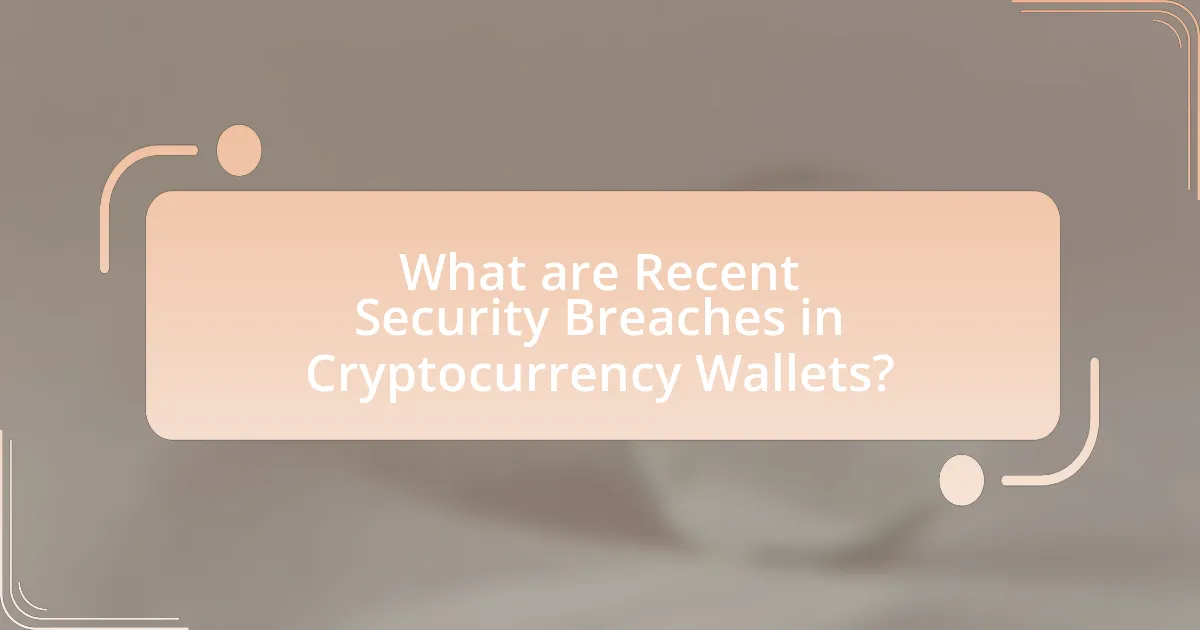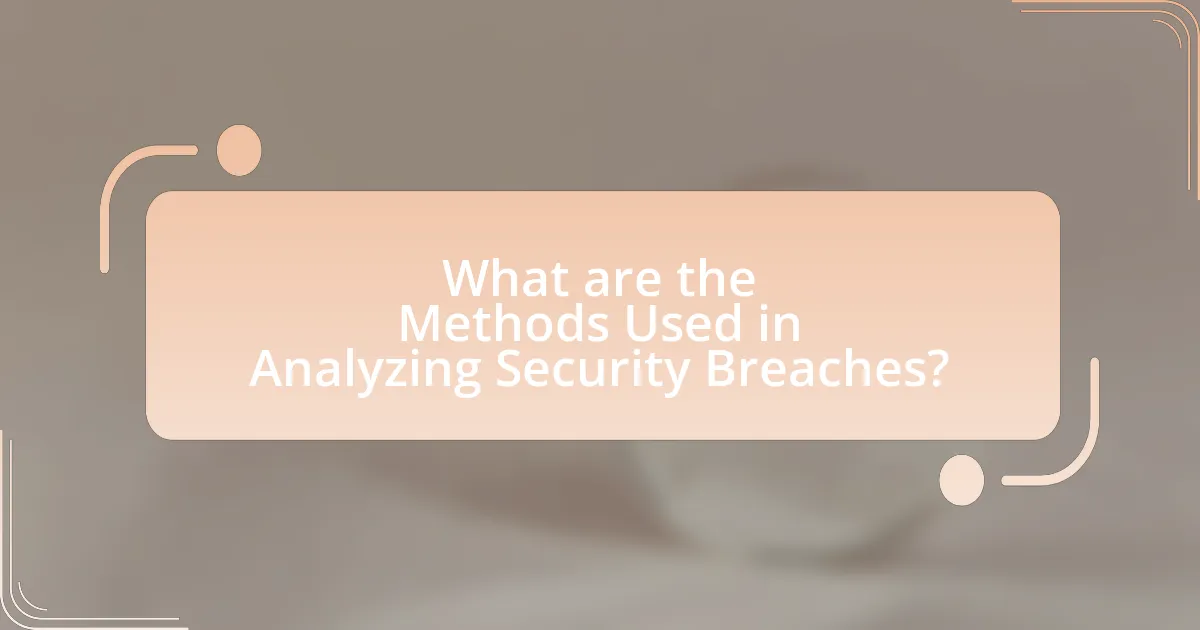The article focuses on analyzing recent security breaches in cryptocurrency wallets, highlighting significant incidents such as the Ronin Network hack in 2022 and the Atomic Wallet compromise in 2023. It examines the impact of these breaches on user trust and the cryptocurrency market, detailing common vulnerabilities like phishing attacks and software flaws that lead to such incidents. The article also discusses methods for analyzing breaches, the importance of user education, and best practices for enhancing wallet security, including the implementation of multi-factor authentication and regular software updates. Key takeaways emphasize the need for both users and wallet providers to adopt robust security measures to mitigate risks associated with cryptocurrency theft.

What are Recent Security Breaches in Cryptocurrency Wallets?
Recent security breaches in cryptocurrency wallets include significant incidents such as the 2022 hack of the Ronin Network, which resulted in the theft of $620 million in Ethereum and USDC, and the 2023 compromise of the Atomic Wallet, where hackers stole approximately $35 million in various cryptocurrencies. These breaches highlight vulnerabilities in wallet security, often due to phishing attacks, inadequate security protocols, or software vulnerabilities. The Ronin Network breach was particularly notable as it involved the exploitation of a validator node, while the Atomic Wallet incident was linked to a series of phishing scams targeting users.
How have these breaches impacted users and the cryptocurrency market?
Security breaches in cryptocurrency wallets have significantly undermined user trust and led to substantial financial losses in the cryptocurrency market. For instance, the 2021 Poly Network hack resulted in the theft of over $600 million, causing panic among users and a temporary decline in market prices. Additionally, such breaches often lead to increased regulatory scrutiny, which can further destabilize market conditions. The aftermath of these incidents typically sees users withdrawing funds from exchanges and wallets, contributing to market volatility and a decrease in overall trading volume.
What are the most notable cases of security breaches in recent history?
The most notable cases of security breaches in recent history include the 2014 Mt. Gox hack, where approximately 850,000 Bitcoins were stolen, amounting to around $450 million at the time. Another significant breach occurred in 2021 when the Poly Network was hacked, resulting in the theft of over $600 million in various cryptocurrencies, although most of the funds were later returned by the hacker. Additionally, the 2022 Ronin Network hack led to the loss of $620 million, making it one of the largest breaches in the decentralized finance sector. These incidents highlight vulnerabilities in cryptocurrency wallets and exchanges, underscoring the need for enhanced security measures.
How do these breaches affect user trust in cryptocurrency wallets?
Security breaches significantly undermine user trust in cryptocurrency wallets. When breaches occur, users often fear for the safety of their assets, leading to a decline in confidence regarding the reliability of these wallets. For instance, a study by Chainalysis in 2021 revealed that 72% of cryptocurrency users expressed concerns about the security of their funds following high-profile hacks. This erosion of trust can result in users withdrawing their investments or opting for alternative storage solutions, further destabilizing the market.
What common vulnerabilities lead to security breaches in cryptocurrency wallets?
Common vulnerabilities that lead to security breaches in cryptocurrency wallets include weak private key management, phishing attacks, and software vulnerabilities. Weak private key management occurs when users fail to securely store or generate their private keys, making them susceptible to theft. Phishing attacks trick users into revealing sensitive information, often through fraudulent websites or emails, leading to unauthorized access. Software vulnerabilities arise from bugs or flaws in wallet applications, which can be exploited by attackers to gain access to funds. According to a report by Chainalysis, over $1.9 billion was lost to cryptocurrency theft in 2020, highlighting the impact of these vulnerabilities.
How do phishing attacks compromise wallet security?
Phishing attacks compromise wallet security by tricking users into revealing their private keys or recovery phrases through deceptive communications. These attacks often involve fraudulent emails, websites, or messages that mimic legitimate services, leading users to input sensitive information unknowingly. According to a report by the Anti-Phishing Working Group, phishing attacks targeting cryptocurrency users have increased significantly, with over 1,000 incidents reported in a single quarter, highlighting the effectiveness of these tactics in breaching wallet security.
What role does software vulnerability play in these breaches?
Software vulnerabilities serve as critical entry points for attackers in breaches of cryptocurrency wallets. These vulnerabilities, such as coding errors or misconfigurations, can be exploited to gain unauthorized access to sensitive information or funds. For instance, the 2021 Poly Network breach, which resulted in the theft of over $600 million, was attributed to a vulnerability in the smart contract code. This demonstrates that unaddressed software vulnerabilities can lead to significant financial losses and compromise user trust in cryptocurrency systems.

What are the Methods Used in Analyzing Security Breaches?
The methods used in analyzing security breaches include forensic analysis, log analysis, and threat intelligence gathering. Forensic analysis involves examining compromised systems to identify the attack vector and the extent of the breach, often utilizing tools like EnCase or FTK. Log analysis entails reviewing system and application logs to trace unauthorized access or anomalies, which can reveal patterns of behavior indicative of a breach. Threat intelligence gathering involves collecting and analyzing data on known threats and vulnerabilities, enabling organizations to understand potential risks and improve their defenses. These methods are essential for accurately assessing the impact of security breaches and developing strategies to prevent future incidents.
How do analysts identify the causes of security breaches?
Analysts identify the causes of security breaches by conducting thorough investigations that include analyzing logs, reviewing system configurations, and examining network traffic. They utilize forensic tools to trace unauthorized access and identify vulnerabilities exploited during the breach. For instance, a study by the Ponemon Institute found that 56% of breaches involved compromised credentials, highlighting the importance of credential analysis in identifying breach causes. Additionally, analysts often perform root cause analysis to determine the underlying issues that allowed the breach to occur, ensuring that similar incidents can be prevented in the future.
What tools and techniques are commonly used in breach analysis?
Commonly used tools and techniques in breach analysis include forensic analysis software, intrusion detection systems, and log analysis tools. Forensic analysis software, such as EnCase and FTK, allows investigators to recover and analyze data from compromised systems. Intrusion detection systems, like Snort and Suricata, monitor network traffic for suspicious activity, while log analysis tools, such as Splunk and ELK Stack, help in identifying anomalies in system logs. These tools collectively enhance the ability to detect, analyze, and respond to security breaches effectively.
How do analysts assess the impact of a breach on affected wallets?
Analysts assess the impact of a breach on affected wallets by analyzing transaction histories, wallet balances, and the extent of unauthorized access. They utilize blockchain analysis tools to trace the flow of funds and identify any illicit transactions linked to the breach. For instance, if a wallet shows a significant drop in balance shortly after a breach, it indicates potential theft. Additionally, analysts may review the security measures in place prior to the breach, such as two-factor authentication and encryption protocols, to determine vulnerabilities exploited during the incident. This comprehensive approach allows analysts to quantify losses and understand the breach’s implications on the overall security landscape of cryptocurrency wallets.
What data is collected during the analysis of security breaches?
During the analysis of security breaches, data collected includes logs of user activity, timestamps of transactions, IP addresses, and details of the compromised systems. This data helps identify the methods used by attackers, the extent of the breach, and the vulnerabilities exploited. For instance, analyzing user activity logs can reveal patterns that indicate unauthorized access, while timestamps can help establish the timeline of the breach. Collecting IP addresses aids in tracing the origin of the attack, and system details provide insight into security weaknesses.
How is user data affected during a security breach?
User data is compromised during a security breach, leading to unauthorized access, theft, or exposure of sensitive information. In the context of cryptocurrency wallets, this can result in the loss of private keys, personal identification details, and financial data, which can be exploited for fraudulent activities. For instance, the 2021 Poly Network breach resulted in the theft of over $600 million in cryptocurrencies, highlighting the severe impact on user data security and trust.
What logs and records are crucial for understanding the breach?
To understand a security breach in cryptocurrency wallets, crucial logs and records include access logs, transaction logs, and system event logs. Access logs provide details on user authentication attempts, indicating unauthorized access or suspicious activity. Transaction logs record all transactions, allowing for the identification of fraudulent transfers or anomalies in user behavior. System event logs capture system-level events, such as software updates or configuration changes, which can reveal vulnerabilities exploited during the breach. Collectively, these logs offer a comprehensive view of the breach’s timeline and impact, facilitating effective incident response and forensic analysis.

What Best Practices Can Prevent Future Security Breaches?
Implementing multi-factor authentication (MFA) is a best practice that can significantly prevent future security breaches in cryptocurrency wallets. MFA adds an additional layer of security by requiring users to provide two or more verification factors to gain access, making it more difficult for unauthorized users to compromise accounts. According to a report by the Cybersecurity & Infrastructure Security Agency (CISA), organizations that implement MFA can reduce the risk of account compromise by 99.9%. Regular software updates and patch management are also critical, as they address vulnerabilities that could be exploited by attackers. The Verizon Data Breach Investigations Report indicates that 80% of breaches involve unpatched vulnerabilities, highlighting the importance of maintaining up-to-date systems. Additionally, educating users about phishing attacks and safe online practices can further mitigate risks, as human error is a leading cause of security breaches.
How can users enhance the security of their cryptocurrency wallets?
Users can enhance the security of their cryptocurrency wallets by implementing multi-factor authentication (MFA). MFA adds an extra layer of protection by requiring not only a password but also a second form of verification, such as a text message code or an authentication app. According to a report by the Cybersecurity & Infrastructure Security Agency (CISA), using MFA can significantly reduce the risk of unauthorized access, as it makes it more difficult for attackers to compromise accounts even if they have the password. Additionally, users should regularly update their wallet software to patch vulnerabilities and use hardware wallets for storing large amounts of cryptocurrency, as these devices are less susceptible to online threats.
What role do two-factor authentication and strong passwords play?
Two-factor authentication (2FA) and strong passwords play a critical role in enhancing the security of cryptocurrency wallets. 2FA adds an additional layer of protection by requiring not only a password but also a second form of verification, such as a code sent to a mobile device, making unauthorized access significantly more difficult. Strong passwords, characterized by a combination of letters, numbers, and symbols, reduce the risk of being easily guessed or cracked through brute-force attacks. According to a study by the Cybersecurity & Infrastructure Security Agency, accounts with 2FA enabled are 99.9% less likely to be compromised, highlighting the effectiveness of these security measures in preventing breaches in cryptocurrency wallets.
How can regular software updates mitigate security risks?
Regular software updates mitigate security risks by patching vulnerabilities that could be exploited by attackers. These updates often include fixes for known security flaws, which, if left unaddressed, can lead to unauthorized access or data breaches. For instance, the 2020 SolarWinds cyberattack highlighted how unpatched software vulnerabilities can be exploited, resulting in significant data compromise across multiple organizations. By consistently applying updates, users can significantly reduce their exposure to such risks, as 60% of breaches are linked to unpatched vulnerabilities, according to the Verizon Data Breach Investigations Report.
What measures should wallet providers implement to protect users?
Wallet providers should implement multi-factor authentication (MFA) to enhance user security. MFA requires users to provide two or more verification factors to gain access, significantly reducing the risk of unauthorized access. According to a study by the Cybersecurity & Infrastructure Security Agency, MFA can block up to 99.9% of automated attacks, demonstrating its effectiveness in protecting sensitive information. Additionally, wallet providers should utilize end-to-end encryption to secure user data during transmission, ensuring that even if data is intercepted, it remains unreadable. Implementing regular security audits and vulnerability assessments can also help identify and mitigate potential threats, further safeguarding user assets.
How can wallet providers improve their security protocols?
Wallet providers can improve their security protocols by implementing multi-factor authentication (MFA) to enhance user verification processes. MFA significantly reduces the risk of unauthorized access, as it requires users to provide two or more verification factors, such as a password and a one-time code sent to their mobile device. According to a study by Microsoft, MFA can block over 99.9% of account compromise attacks. Additionally, wallet providers should regularly conduct security audits and penetration testing to identify vulnerabilities in their systems, ensuring that any weaknesses are promptly addressed. This proactive approach to security has been shown to mitigate risks effectively, as evidenced by the findings from the Ponemon Institute, which reported that organizations that conduct regular security assessments experience fewer data breaches.
What is the importance of user education in preventing breaches?
User education is crucial in preventing breaches as it empowers individuals with the knowledge to recognize and mitigate security threats. Educated users are less likely to fall victim to phishing attacks, which accounted for 90% of data breaches in 2020, according to the Verizon Data Breach Investigations Report. By understanding best practices, such as using strong passwords and enabling two-factor authentication, users can significantly reduce the risk of unauthorized access to their cryptocurrency wallets. This proactive approach to security not only protects individual assets but also contributes to the overall integrity of the cryptocurrency ecosystem.
What are the key takeaways for users regarding cryptocurrency wallet security?
Key takeaways for users regarding cryptocurrency wallet security include the importance of using hardware wallets for enhanced protection, enabling two-factor authentication (2FA) for added security, and regularly updating wallet software to mitigate vulnerabilities. Hardware wallets, such as Ledger or Trezor, store private keys offline, significantly reducing the risk of hacking. Enabling 2FA adds an extra layer of security by requiring a second form of verification, making unauthorized access more difficult. Regular software updates are crucial as they often contain security patches that address newly discovered threats, ensuring that users are protected against the latest vulnerabilities.